When Scott and I first moved into our condo a few years ago, we decided to install two Philips Hue bulbs in our living room to give them a try. Until now, we really had not done much with the bulbs. Turn them on, voila instant light as one would expect.
Philips Hue bulbs in our living room to give them a try. Until now, we really had not done much with the bulbs. Turn them on, voila instant light as one would expect.
Being able to change the colour seemed like a cool feature, but not something that we used. It was a novelty. I also didn’t really understand why I would keep the switch on and control from my smart phone. I just saw these as regular bulbs that happened to show different colours.
We bought two more and put them in my studio/man cave. Even there, we didn’t really use the bulbs to their fullest capacity. More to add ambience as the space looks out onto the balcony with a floor to ceiling window.
Enter my friend M Dave in Amsterdam, who I visited a few weeks ago. Dave has an amazing Hue setup that really showed me how powerful the system is and what is possible. I was introduced to the ‘the power’ of the Hue Motion detector – my killer app!
The Bathroom
The first bit of inspiration he gave me was the bathroom and toilet. See, Scott and I can sometimes forget to turn off the lights in our bathroom. This probably happens to EVERYONE.
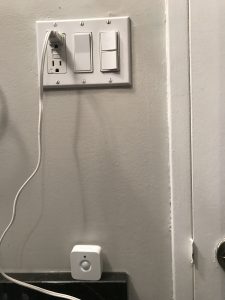 In our bathroom, we have two sets of lights
In our bathroom, we have two sets of lights
- Pot lights which we added when we renovated – one in the shower area, one where the toilet and sink area
- A halogen light directly above the sink which came with the condo
At this point we have only added Hue bulbs to the pot lights. We would have to completely change out the lighting fixture above the sink to something else if we really wanted to put Hue bulbs there.
With the motion detector, not only does it control when the lights go on, it controls how long the light stay on, the type of light you want at the appropriate time of day. Pretty spiffy if you
- need a bright light when waking up, such as something in daylight spectrum and throughout the day
- want a darker light at night to help with getting to sleep, definitely something out of daylight spectrum
It also controls whether or not the light activates based on the amount of day light, prior to or after sundown, and based on the amount of movement in the room.
We placed it on a ledge where the sync is, perfectly out of the way pointed directly at the shower. Since it’s behind the door, movement from the hall does not trigger the light.
There is even a Hue Labs version of the motion detector software, that allows to control a third time set of lighting, so you can have bright daylight in the morning, a more relaxed light through the afternoon and darker light in the evening.
So anyone can have a relaxing shower in any colour they wish. Maybe a bit overkill for a bathroom, but it’s cool.
This then spawned off another idea for me
The Laundry Room
Scott and I have a Laundry Room in our condo where the light often gets left on as well. Also, if you’re carrying a bin of clothes, why not make it easier and use motion control to turn on that light?
So, we did. I had an fifth Hue bulb that I was doing nothing with that I had found while cleaning up my man cave, which was an older first-generation bulb.
It’s clear that when you buy into such a system, that you really should plan out the type of bulbs that you want in the space such as a white-only bulb, or one that does multicolour. Given it’s an older bulb, it doesn’t do certain colours well, most notably blues and green; so its an okay bulb to put in the space. Ideally, I would have saved money using a while only bulb. But hey, we can do laundry in purple light!
Supplied with the motion detector is a magnetic base. The sensor connects to it magnetically, so you can angle the sensor as you like, and from there you can place the sensor on a magnetic surface. All of the shelving in our laundry room is metal and I could place the sensor pretty much anywhere. I have the sensor pointing perpendicularly at the doorway. Given the layout of our unit, movement from the hallway is not captured by the sensor.
That said, Shadow, our cat triggers the light at night, so we had to make sure we programmed the light to nightlight, from 11pm to 8am.
I had one other idea for this setup
The Man cave/Studio
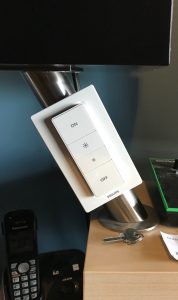

The studio and man cave, I admit, I don’t spend a lot of time in. It’s a small space which often becomes a storage area for things when we have guests over, or at holiday times and such. As much as I clean it up, it very quickly gets filled up with crap. Not ideal for a space that’s really meant to be where I am being creative or chilling, listening to music or playing games.
Often, I’ll pop in to get something, and then pop out and sometimes forgetting to turn off the lights with the intention to go back and do something. So, again, an easy fix with the motion detector. Again, it’s posted perpendicular to the door, low down and done in such a way that walking by the door does not trigger the sensor, turning on the lights. I also have the daylight sensitivity turned up so that it adjusts nicely to daylight savings and standard time.
I also decided to add the remote dimmer so that I can easily control up to four scenes and dimming. It’s probably more than what I need – I always have my phone on me, but I figured I’d give it a try, and I can repurpose it elsewhere if needed.
The cool thing about the dimmer switch is that
- you can mount it in several different ways. Magnetically to a metal surface, stick it to something or you can even screw it into a wall if you wanted
- you can use it as a remote control off where you mount it, so I could carry it with me if I wanted
I’ve mounted it magnetically under one of my studio monitors.
Which brings me to…
The Bedroom Closet
This is the one place where I don’t have a lightbulb that can reproduce the rainbow. Sorry. LOL!
If there is one other room light that constantly gets kept on, it’s our walk-in closet. It irks the heck out of me when this light gets left on.
A room like this doesn’t need a colourful bulb, so I picked up a bulb that only does white light. Now, in the Hue system, you have two kinds of white bulbs – One that only dims or one that has a wide spectrum of white. I chose to go for the wide spectrum of white. You can get this with a dimmer switch, saving a few bucks on the combined package. I am using the dimmer switch else where.
So what do you do early in the morning when your husband is sleeping and you want to get something from the closet without waking them up? Set the motion detector to use a dark colour of light – either the nightlight setting or you could actually use a colour bulb and use, say, a dark blue in the third generation bulb (more below on that).
It’s possible we may swap the light in the closet with the laundry room as we experiment.
Of course, I had to extend this to…
The Bedroom
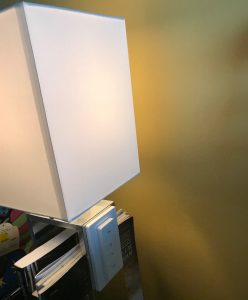
 We love IKEA, it’s all over our condo. We recently picked up new lamps for the bedroom, and if you know IKEA lamps, they all have oddly placed switches. The dimmer I put in the man cave inspired a neat idea – replace the switch with Hue dimmer switch and add a Hue bulb – one each for Scott and me. On top of that, we have a third dimmer switch which is at the entrance to the bedroom.
We love IKEA, it’s all over our condo. We recently picked up new lamps for the bedroom, and if you know IKEA lamps, they all have oddly placed switches. The dimmer I put in the man cave inspired a neat idea – replace the switch with Hue dimmer switch and add a Hue bulb – one each for Scott and me. On top of that, we have a third dimmer switch which is at the entrance to the bedroom.
Hue is a bit quirky in that you can’t link the accessories to a single light bulb. It has to be a room. However, an accessory can be assigned to multiple rooms.
So, Scott’s lamp is one room; my lamp is another, the individual switches control the single room; the one at the entrance turns on both rooms.
Which takes us to…
The Foyer
In the foyer, we have two beautiful pieces of art called “Timber 1” and “Timber 2” by Tim Yanke. We also have the perfect light fixture for the space – A three GU10 ceiling mounted light fixture from IKEA. We actually had the lights prior to the artwork being in the space.
I had been looking at the geofencing capabilities given the significant upgrades made to our space, does it make sense to use that feature? Not until we really took a look at the foyer.
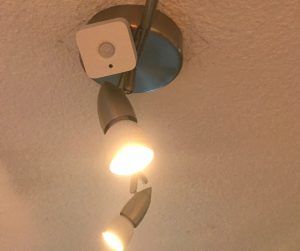
Why not get three GU10 bulbs and a motion detector, so that when people walk into the space to put on shoes or their jacket, that the light comes on automatically. It also makes the geofencing functionality usable. If we had friends in the living room, it doesn’t make sense to geofence to those lights because you’re interrupting people that may have set a particular program.
When Scott or I arrive home, whenever we get to the drive way of the condo building, the lights in our hallway automatically turn on. When we walk in, it then resets the lights to the motion sensor programming depending on the time of day.
Which then takes us to…
The Living Room
The Living room has
- a halogen ceiling light that’s from the 90s. It’s a really neat lamp that works for the space,
- two taller lamps – one with a reading light,
- a curio cabinet with LED lighting that I installed from IKEA which is okay,
- the dining room has a five-bulb halogen ceiling light,
- the open concept kitchen has a six-bulb halogen ceiling light
There isn’t much we can do with the halogen lights in the dining room and the kitchen, really. When we renovated the space, we spent good money on these lights and we really like them, so we are not going to change them. Fair enough.
As I mentioned earlier, I had Hue bulbs in the living room but they were first generation bulbs. I actually moved those bulbs to the bedroom and swapped them for two third generation bulbs which produce deeper blues and greens. They’re gorgeous bulbs.
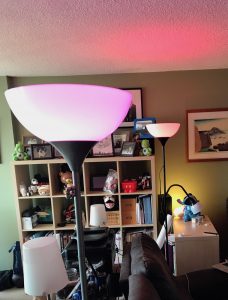
On a whim, I decided to add a Hue Go lamp. I liked the idea that the bulb could be recharged and used in other spaces such as our balcony.
Behind our television is a mirrored wall. It was there when we moved in and it’s a neat element to add depth and the perception of room in the living room. We chose not to take it down when we moved in.
I put the Hue Go behind our television just to give it a try. Wow, the way it adds to the lighting of the space is interesting. The light reflects off the mirror and the ceiling and adds some depth to the lighting in the room. Scott really liked it.
 So, thinking a bit further, rather than putting a light that’s meant to be moved around, behind the TV, let’s move that bulb out somewhere – we’re still figuring out where; and replace it with a Hue Bloom. Which we did.
So, thinking a bit further, rather than putting a light that’s meant to be moved around, behind the TV, let’s move that bulb out somewhere – we’re still figuring out where; and replace it with a Hue Bloom. Which we did.
The Hue Bloom is created somewhat older technology so you really notice a red/green/blue shift in the light depending on the colour. It will do. The Hue Go, however, is fantastic and given the $20 price difference – you really could go with either.
When using scenes, the room pops. When using apps such as Hue Camera it makes the television experience that much more interesting. Watching Tron Legacy, it really adds to an immersive movie experience.
For the living room, we have a Hue Tap Switch. Scott had mentioned it would be neat to have a remote control for the light beyond our phones. I’m not 100% sure how useful the Tap Switch is. At a high level, it combines four switches into one and it uses no batteries. It’s powered based on the push of the button. Kind of neat, that way. That’s the only switch we really have in the living room.
So, what can you do with the lights?
Pretty much anything… Well, almost anything.
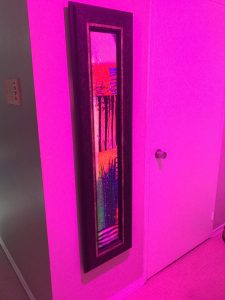 As I mentioned in the front hall, the lights are aimed towards artwork and to provide light to those putting on shoes. If I wanted to, I could add a splash of colour. In hot pink light, the orange and reds in our art really pops.
As I mentioned in the front hall, the lights are aimed towards artwork and to provide light to those putting on shoes. If I wanted to, I could add a splash of colour. In hot pink light, the orange and reds in our art really pops.
In the living room, it’s all about mood.
As I said in the Man cave, it’s all about ambience.
The showcase is really the Living Room. Take a movie like Tron which, in the “Grid” scenes have almost a monochromatic blue hue with the occasional orange for the Recognizers. It’s the perfect movie to experiment with Hue Camera (https://itunes.apple.com/ca/app/hue-camera-for-philips-hue/id965037211?mt=8).
To me, it adds to the immersive environment of the movie. Completely perfect. I’d love to try watching the original Tron as well as Bladerunner. As for watching other kinds of films, we’ll have to see how it works out and report back.
So, what next?
Kitchen?
Scott and I might have our sights set on upgrading the kitchen lights. They’re already LED both pot lights and strip lighting under the counter.
In all honesty, I think going with Hue lighting would be overkill. We don’t need a kitchen that’s got multi coloured lighting and it would be excessive. BUT you know, it would be cool to be able to control the lights in there. So, who knows, it’s not a priority. We have all the wiring to do this.
Bedroom, Part Two?
The bedroom and the guest bedroom both have a ceiling fan with a light, with a smaller bulb in it. Is there much value in having Hue bulbs in these? In the guest room, I could see it, offering our guest a remote to turn off the lamp. In the bedroom? I could see changing the bulb.
The problem is finding the right size of bulb. Do I try a PAR16 bulb? An E14 from Europe won’t work and it’s not the right size of connector anyway.
Curio Cabinet?
My first experiment with Hue Light Strips will probably be our curio cabinet. The lighting provided from IKEA, while quite cool, doesn’t provide the quality of light that I would like in the space. So, this will probably be my first experiment.
Living Room, Part 3?
The halogen space ship, as we call it, the living room works nicely, but it would be nice to not use a halogen bulb. I think the only option would be the Hue Discus or Fair White Ambiance Semi-Flushmount.
There is the Phoenix too, but it doesn’t seem like the right fixture for our space.
Hallway?
We have two Nest Protects in our condo. One in the living room and the other in the hallway. These provide a night light based on motion. They’re perfect for that need.
We still have a fixture with 5 or 6 GU10 bulbs that are halogen based. Do we put Hue bulbs in those? Do we go colour or white? Do we spread some of the colour bulbs and white bulbs across the living room and foyer? What is the value of doing the hallway as well? Do we do motion detection too or more basic control?
Generation of Bulbs?
Yes, there are three generations of some of the bulbs. Specifically, for the colour bulbs aka “White and Colour Ambience” A19 bulbs, here are some details:
- Gen 1 bulbs with model LCT001, they can’t reproduce certainly blues and greens, so they look a bit more white.
- Gen 2 bulbs with model LCT007 are similar to the LCT001 bulbs, to my eyes.
- Gen 3 bulbs such as the LCT014 bulbs, can reproduce deep blues and greens. They’re packaged as “Richer Colours” and they truly are the bulbs you want, these days.
Final Thoughts
Changing out your halogen, incandescent and fluorescent bulbs, I’d say is worth it. The power savings that LED lights give you – enough said.
Taking that to the next level with motion detectors, I think, makes sense. I can’t imagine how much money our parents and grandparents wasted with lights left on, and with electricity prices as expensive as they are in Ontario, it simply makes sense to change your bulbs.
Scott and I live in a condo and we don’t pay for our electricity directly. The building is on a bulk billing system and it’s included in our condo fees. Still, why would we not contribute to try and reduce our hydro costs?
That said, a system like Hue can be expensive. A single colour GU10 bulb is CAD$49.99, and in the US it’s USD$49.99. Americans, if you want a deal, buy your bulbs in Canada (USD$37.80 at today’s exchange rate!). That $49.99 is pretty standard across the board for the colour bulbs.
The white-only bulbs that only dim with the same colour temperature are CAD$14.99. If you want bulb that does any colour of white, those are CAD$29.99. Add CAD$20 for a box that includes a dimmer, which, alone, is regularly CAD$24.99. Not a bad deal.
So my advice is to truly plan out where you truly want colour and where you really need white bulbs. You don’t need colour bulbs everywhere – We certainly don’t in, say, the bedroom.
